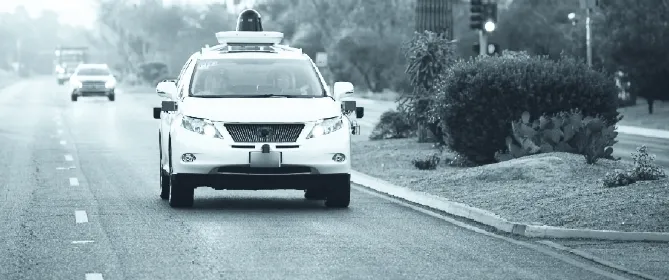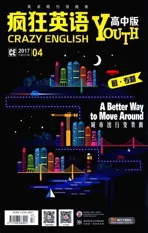我们离无人驾驶还有多远?
2017-06-05ByYukiNoguchi
⊙ By Yuki Noguchi
翻译:思苇
我们离无人驾驶还有多远?
⊙ By Yuki Noguchi
翻译:思苇
Self-Driving Cars Could Help, but That’ll Take a While

I’m standing here watching rush hour build just outside Washington, D.C. It’s here I meet Hesham Rakha, an engineering professor at Virginia Tech with a lifelong interest in traffic: how it flows, and why it sometimes doesn’t.
It is, he says, extremely easy for human drivers to create traffic jams.
Hesham:One little touching of the brake can pull the whole system down.
A driver taps his brake,1)subsequentdrivers react, each braking harder than the next. Soon, traffic is2)crawlingfor no apparent reason.
Hesham:So if we can prevent that3)congestionfrom happening, not only will we let4)vehiclestravel faster, but we’ll also get more vehicles through our system.
Self-driving cars can5)synchronize. They communicate with one another, signaling6)disturbancesahead, avoiding7)backups.
Geoff Wardle teaches transportation design at the Art Center College of Design. He says he expects more people will share8)automatedcars, creating less demand for parking, or the cars might park themselves. Either way…
Geoff:A9)significantamount of traffic congestion is caused by people going round and round the same two or three blocks looking for that place to park.
That’s the positive side of self-driving cars. Here’s the negative.
Geoff:Human beings—we tend to like to try and10)cheatthe system to gain personal advantage.
In fact, Rakha’s research shows that once self-driving cars make their way onto our roads, it will take a while to see any improvements in traffic. The behavior of self-driving cars is predictable, but human behavior is not. So it’s not until there are a lot of driverless cars on the road that we might see some easing of congestion. Put another way, some humans are11)jerkswho try to cut in at the front of the line. Oh, you know who I’m talking about—Rakha certainly does.

Hesham:And they’ll cut across all the lanes and cause everyone12)delay, just because they want to save a couple of seconds. They break down the whole system.
Yuki(Reporter):When people ask you,“So are automated cars gonna reduce my commute time?” what do you tell them?
Hesham:I don’t know the answer. If the road is less congested, more people are gonna be attracted to that road, and so basically it will become congested because it’s supply and demand.
If traffic does improve, in other words, more cars and trucks are likely to use the road. And for us right now…
Yuki:Maybe we should get out of here before traffic gets bad.
Hesham:Yeah, I think it’s a good idea.
1) subsequent [5sʌbsIkwənt] adj. 随后的,后来的
2) crawl [krɔ:l] v. 爬,爬行
3) congestion [kən5dʒest∫(ə)n] n. 交通堵塞,动词形式为congest。
4) vehicle [5vi:Ik(ə)l] n. 交通工具,车辆
5) synchronize [5sIŋkrənaIz] v. 同步
6) disturbance [dI5stз:bəns] n. 干扰,骚动
7) backup [5bækʌp] n. 阻塞
8) automate [5ɔ:təmeIt] v. 自动化
9) signifcant [sIɡ5nIfIkənt] adj. 重大的,显著的
10) cheat [t∫i:t] v. 欺骗,作弊
11) jerk [dʒз:k] n. <俚>笨蛋,混蛋
12) delay [dI5leI] v. 耽搁

看完本期最·专题的三篇文章,你有怎样的感受或想法呢?找上几个同学来开学习会吧(会前不妨收集更多的相关资料与素材),根据这三篇文章进行讨论交流,谈谈你们对交通问题、城市治堵、绿色出行等方面的看法。

就在华盛顿特区外围,我站在路边看着高峰时段慢慢形成。我在这里遇到了希沙姆·拉哈——这位美国弗吉尼亚理工大学的工程学教授一生痴迷于交通问题:车流是怎样运动的,为什么有时候会堵车。
他说,真人司机要造成交通拥堵真是太简单了。
希沙姆:只要有人轻轻踩一下刹车,整个车流就可能因此减速。
一名司机轻轻踩下刹车,后面的司机就会做出反应,一个比一个踩得更起劲儿。很快,车流就会莫名其妙地慢下来。
希沙姆:因此,如果我们可以阻止这种情况的发生,不仅车流能够移动得更快,交通系统也能承载更多车辆。
无人驾驶汽车可以同步校准,车辆之间能互相沟通,当前面出现干扰情况时会发出信号,从而避免塞车。
杰夫·沃德尔在美国艺术中心设计学院教交通设计。他希望以后有更多人会共享无人驾驶汽车,从而减少对停车位的需求,又或者这些车辆可以自己找到停车位。不管怎样……
杰夫:有很大一部分的交通拥堵就是由于人们为了找地方停车,老在那么两三个街区转来转去而造成的。
以上是无人驾驶汽车的优点,接下来该说缺点了。杰夫:人类吧,我们总想骗过系统,好给自己捞点好处。
事实上,拉哈的研究显示,一旦无人驾驶汽车开上马路,我们还要等上一段时间,才能看到这些新车能否改善交通状况。汽车行为是可以预测的,人类行为则不然。所以,我们要等到路上出现很多无人驾驶汽车时,才可能看到拥堵问题有所减轻。换句话说,有些人特别浑,总想在车流中插队。喔,你知道我在说谁——拉哈显然知道。
希沙姆:他们会在所有车道间穿来插去,结果把所有人都耽搁了,就是为了给自己节省那么几秒钟的时间。这些人会把整个系统拖垮。
由纪(记者):当人们问你无人驾驶汽车能不能缩短通勤时间的时候,你是怎么回答的呢?
希沙姆:我真的不知道。如果某条路没那么拥堵,自然就会有更多人跑到那条路上,然后就会造成拥堵——因为这是一个供求关系。
换而言之,如果一条路的交通状况确实得到改善,就会有更多汽车与卡车跑到这条路上来。而对于现在的我们来说……
由纪:也许我们应该在路况变糟之前早点离开。
希沙姆:是啊,这主意不错。

